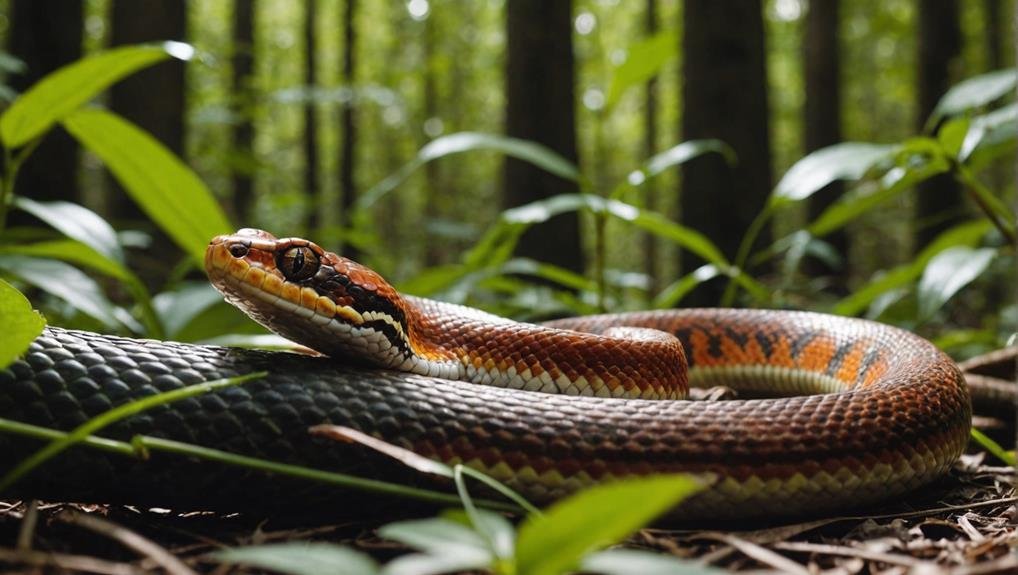When you think about how corn snakes hunt for prey, you should focus on their remarkable combination of stealth, keen senses, and nocturnal behavior. They use their sharp sense of smell and heat-detecting pit organs to track down rodents, birds, and eggs. Their calculated movements and ambush tactics make them effective hunters in various habitats. But how exactly do they manage to overpower their targets? The answer lies in their unique constriction technique, which you’ll find both fascinating and efficient—let’s explore this method in more detail.
Key Takeaways
- Corn snakes use a keen sense of smell and Jacobson’s organ to locate prey.
- They employ stealthy movement and camouflage to approach their prey undetected.
- Corn snakes utilize ambush tactics, often relying on smell to pinpoint rodents.
- They constrict prey using powerful muscles to immobilize it before consumption.
- Pit organs detect heat signatures, aiding in the precise location of warm-blooded prey.
Nocturnal Hunting Behavior
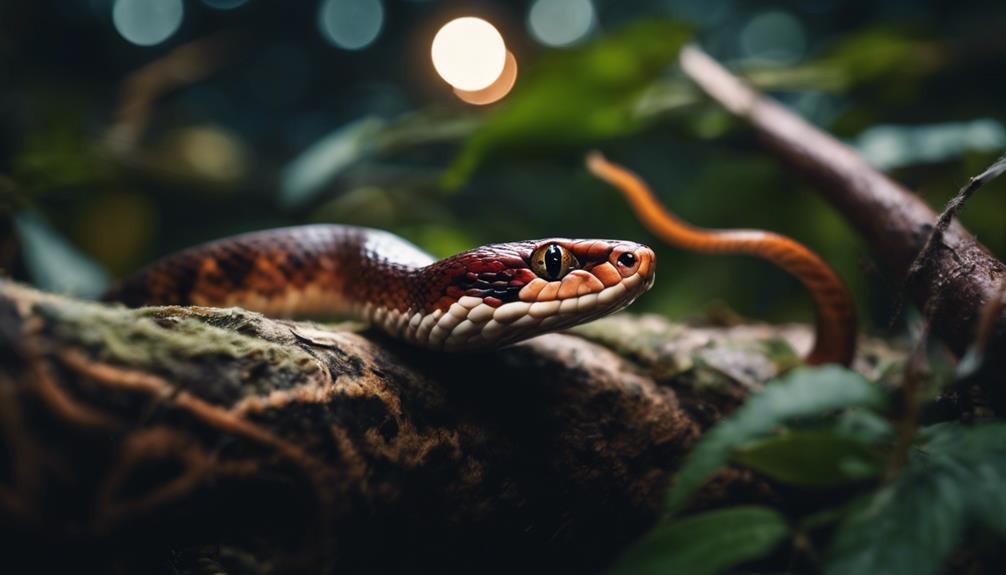

At night, corn snakes rely on their sharp sense of smell to hunt for prey. Their nocturnal hunting behavior means they’re most active when the sun goes down. Their keen sense of smell allows them to detect prey, including small mammals and birds. Patience and stealth are their greatest allies, allowing them to ambush unsuspecting victims.
Corn snakes are skilled climbers, giving them an edge in reaching bird eggs in trees. They use their climbing abilities to expand their hunting territory and access a variety of prey. Once they locate their target, they strike with precision and speed.
Their primary method of subduing prey is through a constricting technique. After capturing their prey, they wrap their bodies around it, applying pressure until the prey is overpowered and unable to escape. This method guarantees that the prey is subdued efficiently before being consumed whole.
Sense of Smell
Corn snakes heavily rely on their keen sense of smell to track down prey in diverse environments. This highly developed sense of smell allows them to locate prey, such as small rodents, reptiles, and amphibians, with remarkable precision. Corn snakes can hunt effectively by detecting scents even in dense foliage or underground caves, where visual cues might be limited.
When a corn snake hunts, it flicks its tongue to gather scent particles from the air, which are then analyzed by the Jacobson’s organ in the roof of its mouth. This organ processes the chemical information and helps the snake pinpoint the location of potential food sources. Whether the prey is hiding under leaves or burrowed into the ground, the corn snake’s sense of smell ensures that no meal goes unnoticed.
Moreover, their sense of smell is integral to their hunting strategies. It allows them to track the movements and presence of prey with unparalleled accuracy, enabling them to capture prey quickly and efficiently.
This olfactory prowess means that corn snakes can adapt to various habitats and maintain a steady diet, making them formidable hunters in the wild.
Tracking Rodents
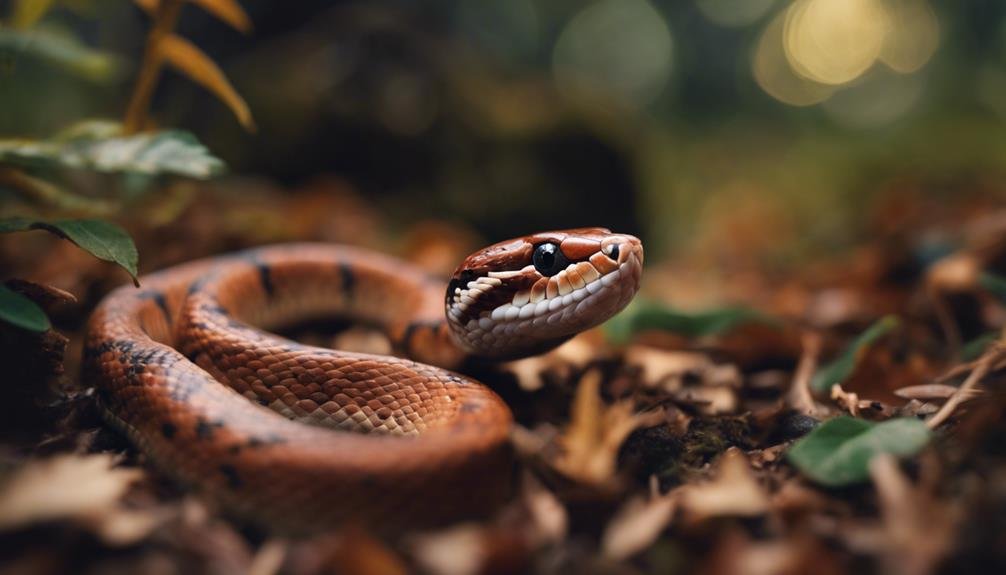

You’ll find that corn snakes are masterful at tracking rodents. They sense heat signatures and detect rodent trails. Then, using their keen sense of smell, they follow these trails, leading the rodents to their next meal.
Once in position, they employ ambush tactics to strike quickly and efficiently.
Sensing Heat Signatures
Imagine you’re a corn snake, hunting in the dark and relying on your specialized pit organs to detect the heat signatures of nearby rodents. These pit organs on your face are remarkable tools that allow you to sense the heat emitted by warm-blooded animals, even in low-light conditions.
As a nocturnal predator, you depend on this ability to detect heat to track and capture your prey efficiently. Your hunting strategy revolves around pinpointing the exact location of small mammals, birds, and other warm-blooded creatures. By focusing on the heat signatures they emit, you can stealthily approach and ambush them precisely.
This heat-sensing capability is essential in your natural habitats, where darkness can obscure visual cues but can’t hide the thermal footprints of your prey. Detecting these heat signatures helps you become an efficient hunter, securing the food you need to survive.
When most animals rely on sight and sound in the quiet of the night, your specialized pit organs give you a significant advantage. By harnessing this natural infrared detection system, you excel as a nocturnal predator, adept at maneuvering the challenges of your environment.
Detecting Rodent Trails
With a keen sense of smell, you can detect the scent trails left by rodents, guiding you directly to your next meal. Corn snakes excel at following these rodent trails, which lead them straight to potential prey like mice and rats. Your sense of smell is finely tuned, allowing you to pick up even the faintest scent trails.
As you stalk your prey, you employ a stealthy approach, moving slowly and silently to avoid detection. This hunting strategy is incredibly effective, enabling you to get close enough to ambush your target.
By tracking these scent trails, you can accurately locate prey, setting yourself up for a successful capture.
Corn snakes have evolved this method to find and consume their preferred food sources consistently. Your ability to follow scent trails is critical to your hunting strategy. It allows you to navigate your environment and pinpoint exactly where rodents hide.
Utilizing Ambush Tactics
By leveraging your keen sense of smell, you can patiently wait in hidden spots until a rodent comes within striking distance. Your ambush tactics make you a formidable predator, allowing you to track down prey effectively.
As a corn snake, you rely on your sense of smell to detect the presence of rodents in your environment. Once you’ve located a potential meal, you remain motionless, blending into your surroundings until the perfect moment to strike arises.
When the rodent is close enough, you strike quickly and use constriction to subdue your prey. This method guarantees you can secure your food efficiently without expending unnecessary energy.
Your nocturnal hunting habits further enhance your ability to catch the most active rodents at night.
Your instincts and physical abilities make you a skilled hunter, capable of thriving in various environments.
Here’s a quick look at how you master the art of ambush hunting:
- Patience: Waiting silently in hidden spots.
- Precision: Striking at the exact right moment.
- Strength: Using constriction to immobilize prey.
- Stealth: Blending into your surroundings.
- Efficiency: Hunting primarily at night when prey is most active.
Your combination of skills and instincts ensures you remain an efficient predator.
Stealthy Movement
You’ll be amazed how corn snakes use silent stalking strategies to approach their prey unnoticed.
By camouflaging in their environment, they blend seamlessly with their surroundings.
With slow, calculated advances, they get close enough to strike swiftly and effectively.
Silent Stalking Strategies
Corn snakes masterfully blend into their environment, using stealthy movements to approach their prey unnoticed. Their excellent camouflage allows them to blend into surroundings like leaf litter, tree bark, and undergrowth. This gives them a significant advantage in hunting, as they can get very close to their target without alarming it.
Silent stalking is key to successful corn snake hunting. Corn snakes move slowly and deliberately, ensuring each movement is calculated to avoid detection. Their sharp sense of smell is essential in this process, helping them locate prey even when it’s hidden. They can track down potential prey items by following scent trails.
Here’s how cornsnakes make the most of their silent stalking strategies:
- Stealthy movements: Slow and deliberate movements keep them hidden.
- Excellent camouflage: Their patterns blend seamlessly with natural surroundings.
- Sharp sense of smell: They rely on it to locate and track prey.
- Tree climbing abilities: This gives them access to prey in higher locations.
- Silent stalking: A systematic approach that minimizes noise and vibrations.
These strategies ensure corn snakes can approach their prey with minimal risk of detection, making them efficient and effective hunters.
Camouflaging in Environment
In addition to their silent stalking techniques, these snakes utilize their natural coloration to blend seamlessly into their environment, making them nearly invisible to their prey. Corn snakes are masters of camouflage, using their patterned scales to mimic the colors of their surroundings. This ability to blend in allows them to avoid detection and move undetected through their habitat.
By relying on their natural camouflage, corn snakes can approach prey stealthily. They can patiently stalk their targets, getting close enough to launch a surprise attack. This stealthy movement is essential for hunting efficiently, as it minimizes the chances of alarming their prey.
| Advantage | Description |
|---|---|
| Camouflage | Mimics colors of surroundings |
| Stealthy movement | Moves undetected to approach prey |
| Efficient hunting | Avoids detection, stalks prey patiently |
When a corn snake moves through leaf litter or among rocks, its coloration ensures it remains hidden. This blending in is not just about avoiding detection from prey but also from potential predators. By staying camouflaged, these snakes can hunt effectively and stay safe simultaneously. Their ability to blend in and move undetected makes them formidable hunters in their natural environment.
Slow, Calculated Advances
With slow, calculated advances, these snakes carefully maneuver through their environment, ensuring they remain undetected by their prey. Corn snakes rely on their keen sense of smell to track down small rodents, reptiles, and amphibians. Their stealthy movement allows them to close in on their targets without alarming them.
In their pursuit, corn snakes showcase several impressive hunting strategies:
- Tracking prey: Using their keen sense of smell to locate potential meals.
- Climbing trees: Scaling trees to access bird eggs and other high-up prey, demonstrating their versatility.
- Nocturnal behavior: Being more active at night when their prey is on the move increases their hunting success.
- Constricting abilities: Coiling around their prey to suffocate them before consumption.
- Stealthy movement: Moving silently and slowly to avoid detection.
Once they’ve gotten close enough, corn snakes use their constricting abilities to coil around their prey and suffocate them. Their nocturnal behavior ensures they’re most active when their prey is out and about, giving them an edge. With these versatile hunting strategies, corn snakes are adept predators, successfully capturing and consuming their targets.
Habitat Exploration
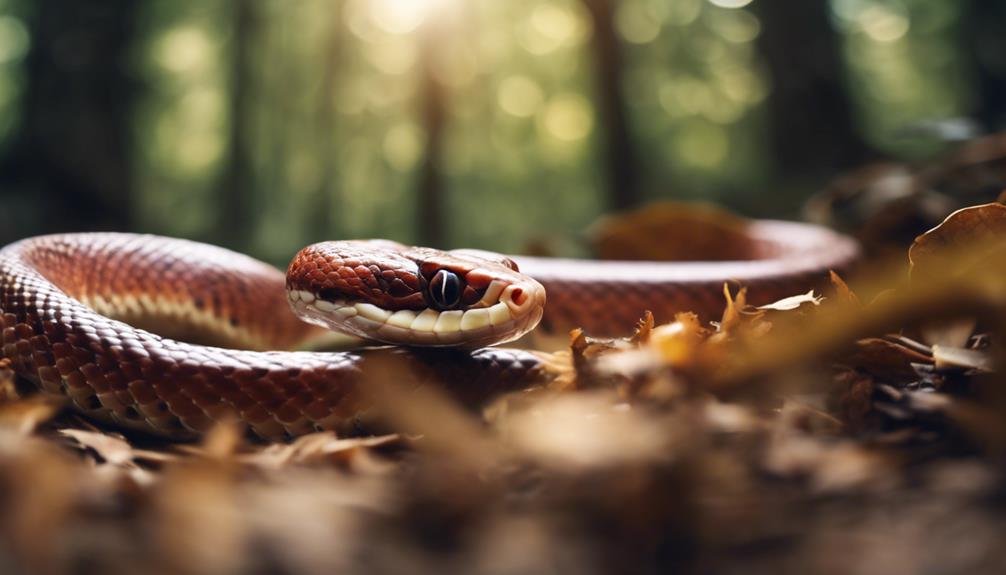

Corn snakes explore their habitat at night and rely on their keen sense of smell to track down prey. They venture into overgrown fields, dense forests, and even abandoned buildings, using their olfactory prowess to detect mice, rats, birds, and lizards. This nocturnal exploration allows them to hunt efficiently while avoiding many daytime predators.
Corn snakes are agile climbers, capable of ascending trees and cliffs in search of bird eggs or to reach new hunting grounds. Their climbing abilities expand their hunting behavior, enabling them to exploit various levels of their environment.
During the day, they remain hidden underground or under logs, rocks, and debris, conserving energy and staying safe until nightfall.
This nightly routine is essential for controlling rodent populations. Corn snakes play an important role in maintaining the balance of their ecosystem by keeping the numbers of mice and rats in check. Their exploration of diverse habitats not only ensures their survival but also supports the health of the environment.
As you observe these snakes, you’ll appreciate the intricate ways they navigate and thrive within their habitats. They showcase remarkable adaptability and efficiency in their hunting practices.
Capturing Prey
After locating their prey with remarkable olfactory skills, corn snakes swiftly move in to capture and constrict their target. They hunt efficiently using their keen sense of smell, primarily targeting small rodents like mice and rats. These snakes excel at capturing prey due to their agility and strategic hunting methods.
Corn snakes are also skilled climbers, enabling them to ascend trees to hunt for bird eggs or nestlings. They actively hunt at night, taking advantage of their nocturnal nature to catch prey when it’s most vulnerable. When they spot their target, they strike quickly, wrapping their bodies around the prey to suffocate it before swallowing it whole.
Here’s a quick look at how corn snakes capture their prey:
- Keen sense of smell: Helps locate prey, especially small rodents.
- Skilled climbers: Allows them to ascend trees and hunt for bird eggs or nestlings.
- Night hunting: They hunt efficiently when their prey is active at night.
- Active hunters: Young snakes often hunt lizards and tree frogs.
- Swallowing whole: After constricting their prey, they swallow it whole.
Constriction Technique
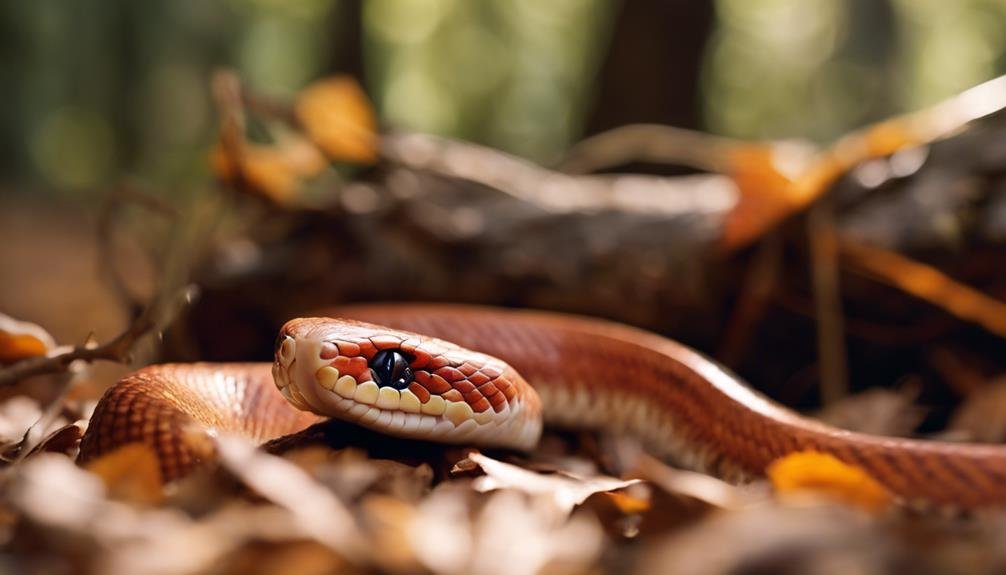

Corn snakes use their powerful constriction technique to subdue prey, wrapping their bodies tightly around the target to suffocate it. When they hunt for prey, corn snakes don’t depend on venom. Instead, they use their muscular bodies to overpower and immobilize their targets.
By coiling around their prey, they exert pressure until it suffocates, ensuring the prey can’t escape. This method effectively captures small mammals, birds, and even other reptiles. Once the prey is subdued, corn snakes proceed to swallow it whole.
Thanks to their flexible jaw structure, corn snakes can consume larger animals than their heads. This ability to swallow prey whole is vital for their efficient digestion. The constriction technique helps corn snakes secure their food source and allows them to hunt various prey.
Corn snakes can rely purely on their physical strength and technique without venom, making them formidable hunters in their natural habitat. Understanding this constriction method is key to appreciating how corn snakes thrive and maintain their dietary needs in the wild.
Overpowering Methods
Beyond constriction, corn snakes employ various overpowering methods to secure their prey. Their sense of smell is important in locating potential meals like mice, rats, birds, and lizards. They don’t just rely on one technique; these snakes are versatile and resourceful hunters.
Corn snakes are excellent climbers. They often ascend trees to hunt for bird eggs or roosting birds. This ability allows them to access prey that might otherwise be out of reach. Their agility and climbing skills give them an edge in diverse environments.
Corn snakes become especially active at night, using the cover of darkness to their advantage. Being nocturnal hunters means they’re often on the prowl when their prey is also active, increasing their chances of a successful hunt.
Here are some of the ways corn snakes overpower their prey:
- Using their keen sense of smell to locate and track potential prey items.
- Climbing trees to access bird eggs and roosting birds.
- Actively searching for smaller prey like tree frogs and lizards.
- Nocturnal hunting is used to catch prey off guard during nighttime.
- Constricting their prey to suffocate and immobilize it for an easy meal.
These methods make corn snakes efficient and effective predators in their natural habitats.
Consumption Process
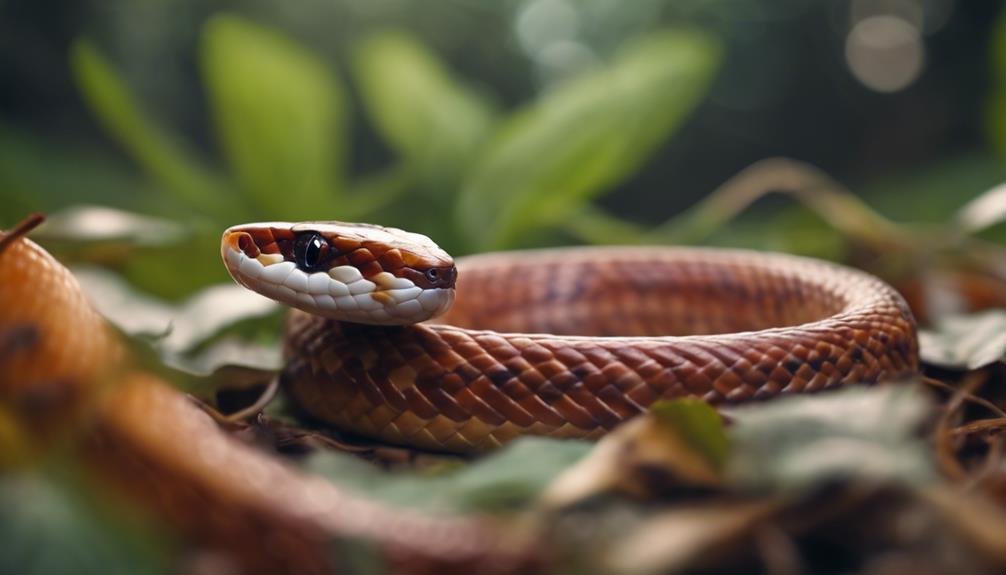

When a corn snake captures its prey, it uses powerful muscles to swallow the meal whole. This remarkable swallowing mechanism allows the snake to consume prey much larger than its head.
After the hunting behavior of constricting and suffocating the prey, the snake begins the process of swallowing. It uses its flexible jaws and specialized muscles to immobilize prey, ensuring it can’t escape during the suffocation process.
Corn snakes primarily feed on small mammals like mice and rats, playing an important role in rodent control. This is vital for maintaining ecosystem balance. Occasionally, they might consume birds, eggs, and even amphibians or reptiles. Their feeding habits are adapted to their environment, ensuring they can thrive.
Once the prey is subdued, the corn snake’s swallowing technique comes into play. It methodically works from the head down, gradually inching the prey into its digestive tract. This prey consumption can take some time as the snake carefully maneuvers its meal.
After consuming their prey, corn snakes can go for several days or weeks without eating again, showcasing their efficient energy use and unique feeding strategy.
Conclusion
In your journey learning about corn snakes, you’ve seen how they expertly combine nocturnal habits, a sharp sense of smell, and stealthy movements to hunt.
They precisely track rodents and prey, using their pit organs to detect heat.
When they strike, they rely on powerful constriction to subdue their targets.
Finally, they consume their prey whole, showcasing their efficient hunting prowess in diverse habitats.
Corn snakes truly are remarkable hunters, aren’t they?
FAQs
1. How Do Corn Snakes Catch Their Prey?
Corn snakes use ambush tactics and camouflage techniques to catch their prey. They rely on heat sensing, scent trails, and nocturnal behavior to hunt. Their environmental adaptation and sensory perception aid in predator avoidance and feeding frequency.
2. How Does a Snake Hunt Its Prey?
You’ll notice a snake’s predatory behavior involves advanced hunting techniques. They use sensory adaptation for prey detection and then employ an ambush strategy on their hunting grounds. Their predatory instincts guarantee efficient prey capture, leading to successful feeding habits.
3. What Are Corn Snakes’ Favorite Food?
Corn snakes’ favorite food includes small rodents like mice, fitting their prey size and dietary habits. In their natural habitat, they also enjoy reptiles and amphibians. Feeding frequency and diet vary seasonally, especially for juveniles in captivity.
4. How Do Rat Snakes Eat Their Prey?
When observing rat snakes, you’ll notice their hunting techniques involve nocturnal hunting and prey immobilization through constriction methods. Their prey selection varies seasonally. Habitat influences feeding frequency, and their digestion adapts to these varying conditions.

